How to Convert Lecture Notes into Bite-Sized Visual Lessons
Your lecture notes are probably a mess—scattered ideas, incomplete sentences, concepts you didn't fully understand when the professor was talking. Even if they're well-organized, they're still just walls of text that are boring to review.
What if you could transform those messy notes into clean, visual, bite-sized lessons you can review in minutes instead of hours? Here's how.
The Problem with Traditional Lecture Notes
Standard note-taking creates problems:
- Incomplete information - Missed things while writing
- Disorganized structure - Ideas scattered randomly
- Hard to review - Where do you even start?
- No visual elements - Just text, text, text
- Time-consuming - Re-reading takes forever
- Passive review - Just reading, no active learning
- Unclear connections - Can't see how concepts relate
Result: You have notes, but they don't help you learn.
The Power of Bite-Sized Visual Lessons
Visual lessons transform learning by:
- Chunking information - One concept per lesson
- Adding visual context - Diagrams show relationships
- Creating structure - Logical flow through material
- Enabling quick review - 5-10 minute sessions
- Making it engaging - Interactive elements included
- Supporting memory - Visual recall is 6x stronger
- Showing connections - How concepts link together
How to Convert Lecture Notes to Visual Lessons
Step 1: Gather Your Lecture Notes
Collect notes you want to transform:
- Handwritten notes (photograph or transcribe)
- Typed notes from class
- PowerPoint slides from professor
- Textbook readings for that lecture
- Supplementary materials
Step 2: Access the Lesson Creator
Navigate to https://www.miskies.app/miskies and click "Create New Miskie".
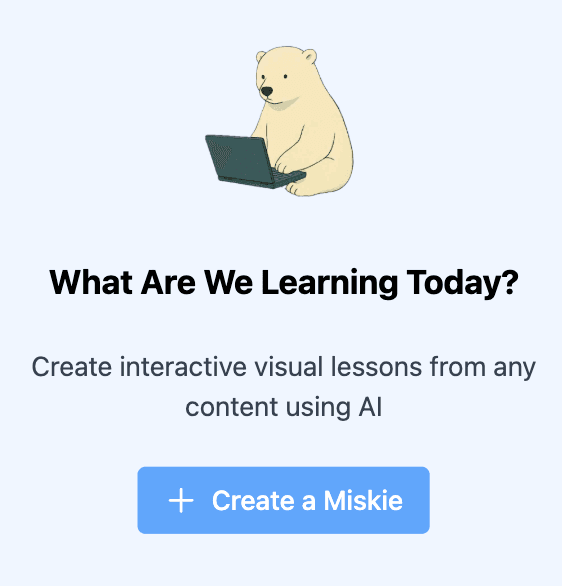
Step 3: Define Your Visual Lesson
Set up for effective learning:
- Lesson name: "Week 3 Lecture - Protein Synthesis"
- Learning objective: "Understand transcription and translation"
- Review time: "10 minutes"
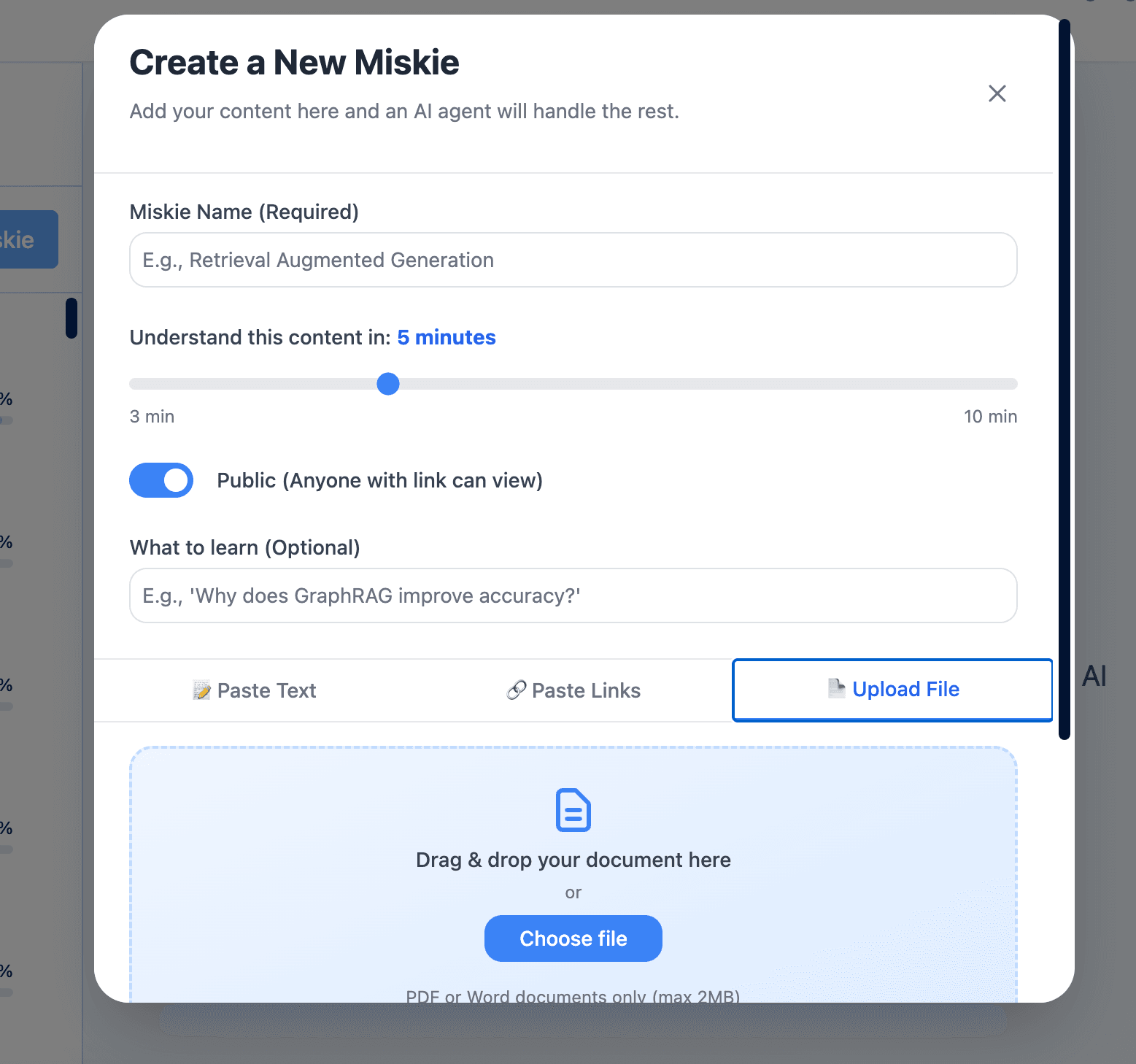
Step 4: Input Your Notes
Add your lecture materials:
- Paste typed notes directly
- Upload note documents (Word, PDF)
- Add lecture slides from professor
- Include reading materials covered in lecture

Step 5: Receive Visual Lessons
In 30 seconds, your messy notes become:
Organized Visual Slides:
Each key concept gets its own slide with:
- Clear title and focus
- Visual diagram explaining the concept
- Supporting context and details
- Logical progression to next concept
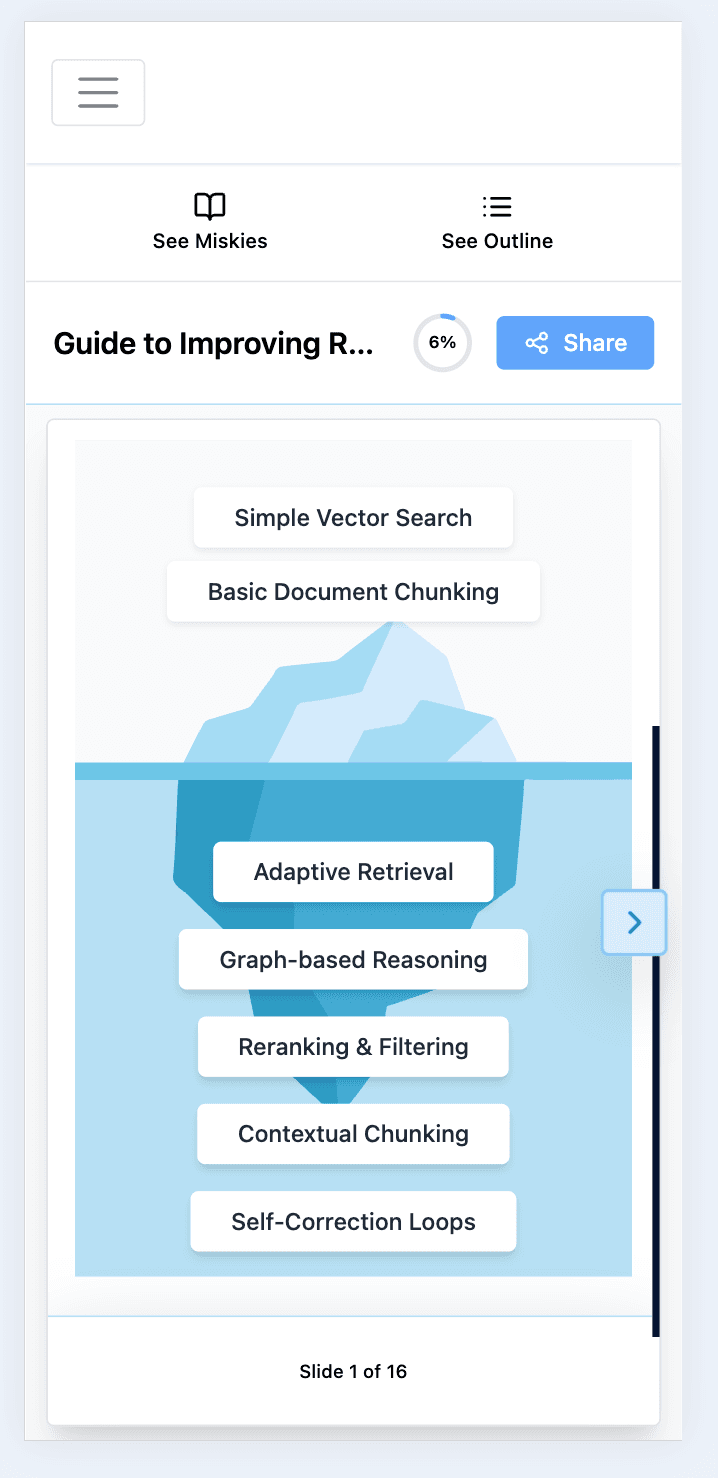
Multiple Diagram Types automatically selected:
- Flowcharts - For processes and sequences (e.g., protein synthesis steps)
- Pyramids - For hierarchies (e.g., biological organization)
- Venn diagrams - For comparisons (e.g., prokaryote vs eukaryote)
- Sequences - For chronological events (e.g., cell cycle phases)
- Scales - For ranges (e.g., pH scale)
- Icebergs - For visible vs hidden aspects (e.g., observable vs molecular)
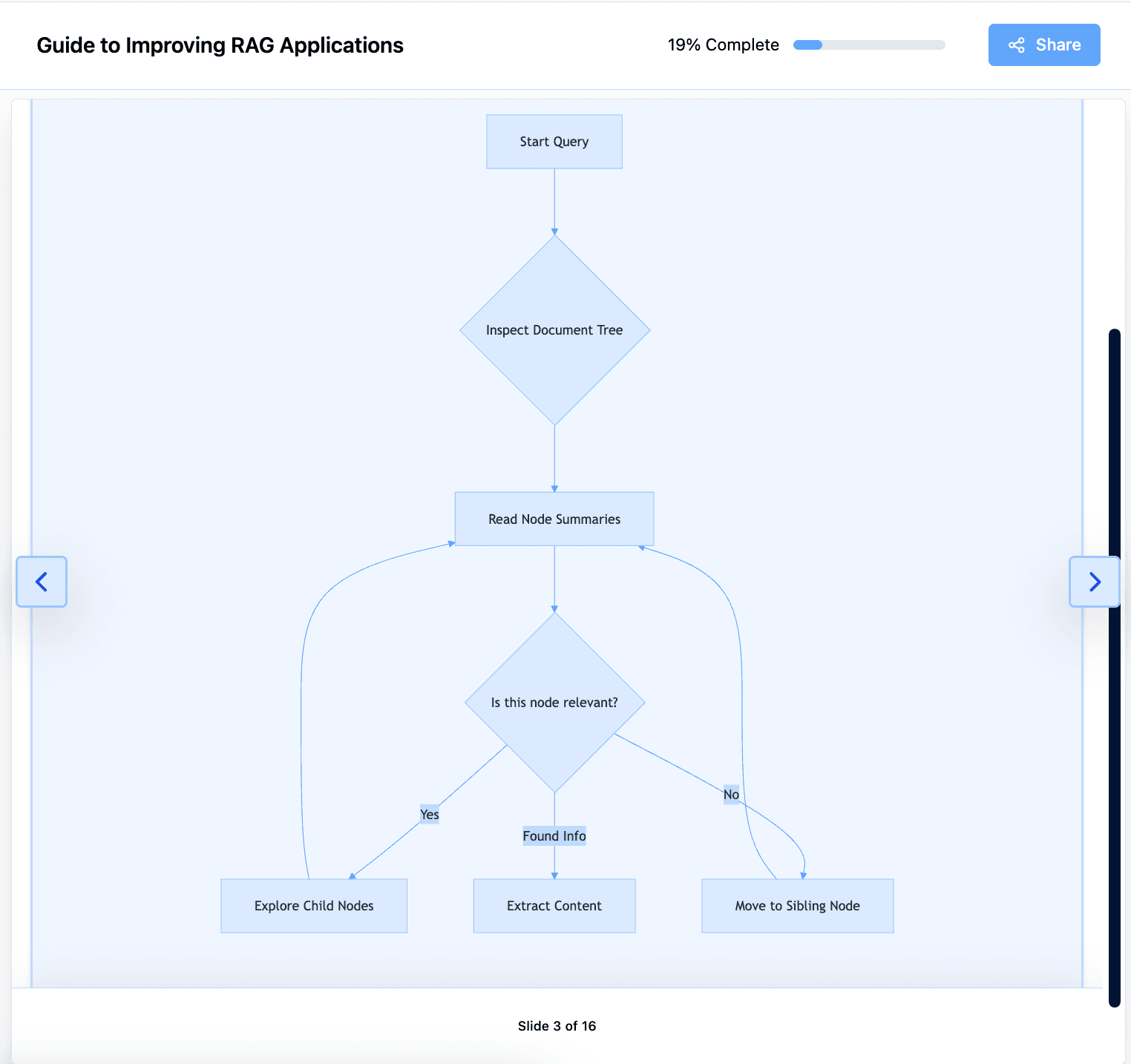
Interactive Learning Elements:
- Hands-on exercises applying concepts
- Knowledge check questions
- Real-world scenarios
- Practice problems
Before and After Transformation
Before: Messy Lecture Notes
Cell membrane - phospholipid bilayer
- hydrophobic tails inside
- hydrophilic heads outside
proteins embedded... integral? peripheral?
function: selective permeability
transport: passive (diffusion, osmosis, facilitated)
active transport needs ATP
sodium-potassium pump example
[missing info - ask Sarah]
After: Bite-Sized Visual Lessons
Lesson 1: Cell Membrane Structure
- Slide: Diagram of phospholipid bilayer showing heads/tails
- Interactive: Label the components
Lesson 2: Membrane Proteins
- Slide: Venn diagram comparing integral vs peripheral proteins
- Quiz: Which type can be removed without disrupting membrane?
Lesson 3: Passive Transport
- Slide: Flowchart showing diffusion → osmosis → facilitated diffusion
- Exercise: Match transport type to example
Lesson 4: Active Transport
- Slide: Sequence diagram of sodium-potassium pump cycle
- Problem: Calculate ATP needed for transport scenario
Best Strategies for Note Conversion
Strategy 1: Convert Immediately After Class
When: Within 24 hours of lecture Why: Information still fresh, can fill gaps How: Add notes + textbook reading for complete lessons
Best for: Staying current with coursework
Strategy 2: Batch Convert for Exam Prep
When: 1-2 weeks before exam Why: Creates comprehensive review materials How: Combine all lecture notes for topic/unit
Best for: Efficient exam preparation
Strategy 3: Progressive Building
When: Weekly throughout semester Why: Builds complete course library How: Convert each week's notes systematically
Best for: Long-term retention and mastery
Strategy 4: Problem-Area Focus
When: When struggling with specific topics Why: Targets confusion with visual clarity How: Convert notes on difficult concepts only
Best for: Filling knowledge gaps
Enhancing Your Visual Lessons
Add Context from Multiple Sources
Combine:
- Your lecture notes (what professor emphasized)
- Textbook section (comprehensive details)
- Online articles (alternative explanations)
- Lab materials (practical applications)
Result: Complete, multi-perspective visual lessons
Focus on What Matters
Not all notes are equal—prioritize:
- Concepts professor emphasized repeatedly
- Topics on syllabus or study guide
- Areas you find confusing
- Material relevant to exams/assignments
Create Connected Lesson Series
Build progressive understanding:
- Foundation lessons - Basic concepts first
- Development lessons - Build on basics
- Application lessons - Use in context
- Integration lessons - Connect to big picture
Study Techniques with Visual Lessons
The Quick Review Method (5 Minutes)
- Skim through visual slides before next class
- Focus on diagrams for visual memory
- Perfect for staying current
The Deep Study Method (15-20 Minutes)
- Review each slide carefully
- Redraw key diagrams on paper
- Complete all interactive exercises
- Take all quizzes
The Active Recall Method
- Review lesson once
- Close materials
- Recreate diagrams from memory
- Explain concepts aloud
- Check accuracy
The Spaced Repetition Method
- Review on day 1 (immediately)
- Review on day 3 (short session)
- Review on day 7 (focus on weak areas)
- Review on day 14 (comprehensive)
- Review before exam (rapid refresh)
Organizing Your Lesson Library
By Course
Create collections for each class:
- BIO101 - All biology lessons
- CHEM201 - All chemistry lessons
- HIST150 - All history lessons
By Topic
Organize within courses:
- Cell Biology lessons
- Genetics lessons
- Evolution lessons
By Date
Track chronologically:
- Week 1 lectures
- Week 2 lectures
- Week 3 lectures
By Importance
Priority-based organization:
- ⭐⭐⭐ Exam-critical material
- ⭐⭐ Important concepts
- ⭐ Supplementary content
Collaborative Learning with Lessons
Share with Study Groups
Benefits:
- Everyone has access to clear materials
- Compare understanding across notes
- Fill gaps in individual notes
- Study together more effectively

How to share:
- Generate public link
- Post in study group chat
- Review together before exams
- Discuss any confusing slides
Learn from Others' Lessons
Browse community lessons: https://www.miskies.app/miskies/explore
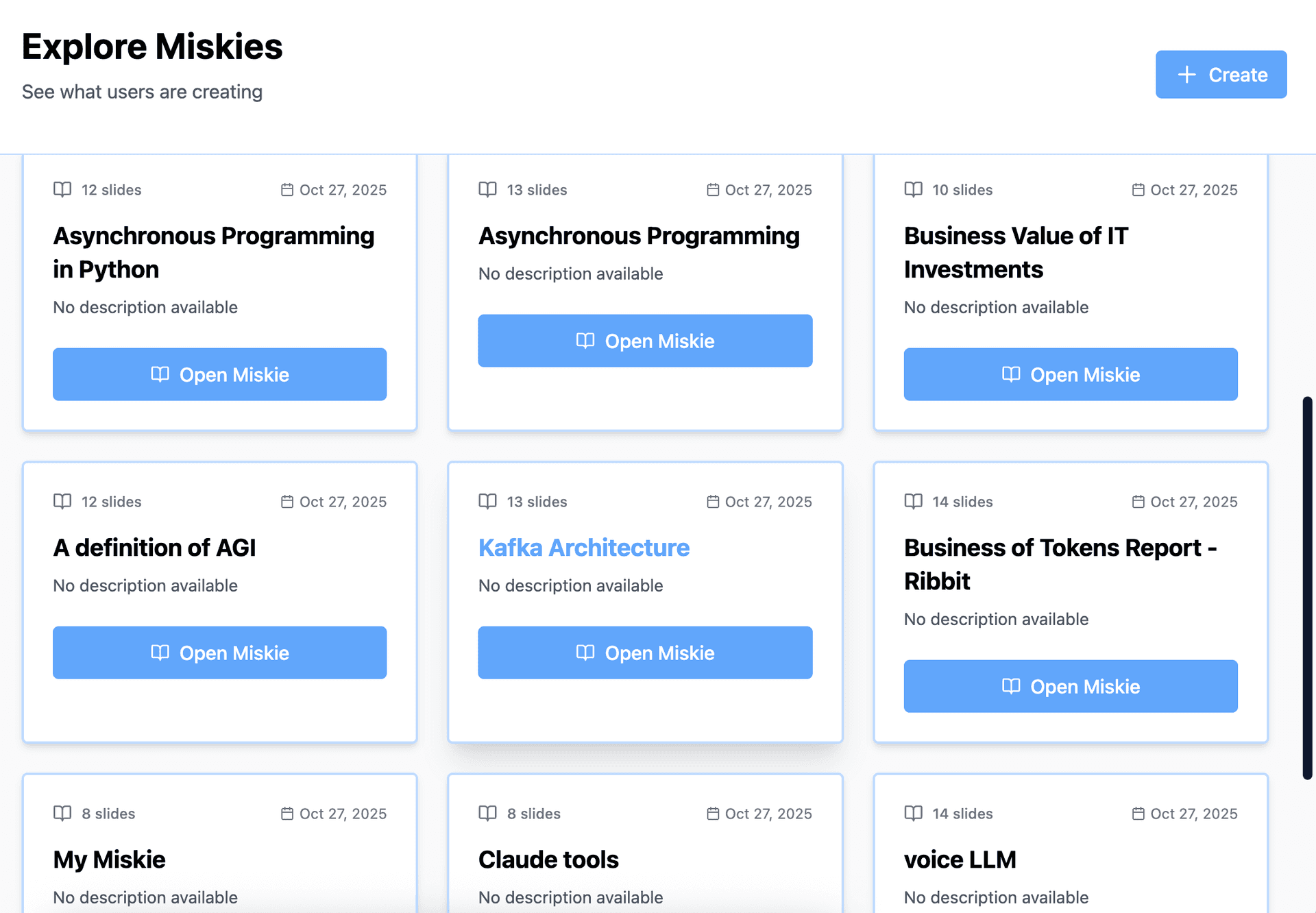
Discover:
- How others understood same lectures
- Different visual approaches
- Additional practice problems
- Alternative explanations
Create Better Together
Collaborative lesson building:
- Each person converts different lectures
- Share all lessons with group
- Everyone benefits from everyone's work
- Build comprehensive course library together
Different Subjects, Different Visuals
Science Lectures → Process Diagrams
- Chemical reaction sequences
- Biological processes
- Physics problem approaches
- System interactions
Math Lectures → Step-by-Step Visuals
- Proof breakdowns
- Formula derivations
- Problem-solving sequences
- Concept relationships
History Lectures → Timeline & Comparison
- Event sequences
- Cause-effect relationships
- Era comparisons
- Historical figure connections
Business Lectures → Framework Diagrams
- Model visualizations
- Strategy processes
- Market analyses
- Decision matrices
Language Lectures → Structure Maps
- Grammar rule hierarchies
- Vocabulary groupings
- Sentence pattern flowcharts
- Usage comparisons
Benefits of Visual Lesson Conversion
Compared to Traditional Notes:
Reviewing Text Notes:
- ❌ Takes 2-3 hours to review
- ❌ Hard to stay focused
- ❌ Passive reading
- ❌ Information doesn't stick
Reviewing Visual Lessons:
- ✅ Review in 10-15 minutes
- ✅ Engaging and interesting
- ✅ Active interaction
- ✅ Strong visual memory
Real Student Success Stories
Biology Major: "Converted all my genetics lecture notes. Cut my study time from 4 hours to 45 minutes before exams. Grade improved from B+ to A."
Engineering Student: "My notes were always incomplete. Visual lessons filled the gaps and made complex processes clear. Finally understand thermodynamics."
Pre-Med Student: "Made visual lessons for entire anatomy course. Saved them for MCAT prep. Best decision ever—visual memory made recall so much easier."
Business Student: "Turned strategy framework notes into diagrams. Now I can actually apply them to cases instead of just memorizing definitions."
Common Questions
Q: What if my notes are really messy? A: AI can work with incomplete notes. Add textbook sections to fill gaps.
Q: Should I convert notes from every lecture? A: Focus on important or confusing topics first, then expand.
Q: Can I edit the visual lessons? A: Lessons are optimized for learning. Create multiple versions if needed.
Q: How long are saved lessons accessible? A: Forever—build a complete course library over time.
Q: Can I combine multiple lectures? A: Yes! Combine related lectures for comprehensive topic lessons.
Tips for Best Results
1. Add Context to Sparse Notes
If notes are brief:
- Include relevant textbook sections
- Add professor's slide deck
- Include online resources covering topic
2. Be Specific About Confusion
In learning objective, note:
- "Especially understand X concept"
- "Focus on relationship between Y and Z"
- "Clarify difference between A and B"
3. Supplement with Examples
AI generates better lessons with:
- Example problems from notes
- Real-world applications mentioned
- Professor's specific examples
4. Review Immediately
Best time to review visual lessons:
- Same day as lecture (while fresh)
- Before next class (stay current)
- During study session (active learning)
5. Iterate and Improve
Over semester:
- Convert more notes as needed
- Focus lessons on exam topics
- Build interconnected library
- Share best lessons with classmates
Start Converting Your Notes Today
Stop letting messy lecture notes slow down your learning. Transform them into clean, visual, bite-sized lessons you can master in minutes.
Visit Miskies AI and convert your first lecture notes into visual lessons in 30 seconds.
Completely Free • Unlimited Conversions • Study Anywhere
Your notes deserve to be more than just text on a page.
Keywords: convert lecture notes, visual study lessons, transform class notes, lecture note organization, bite-sized learning, visual note conversion, study from lecture notes, note-taking tools, lecture review materials, class notes to diagrams